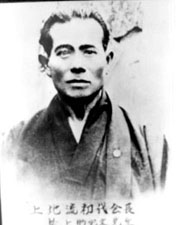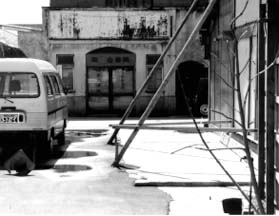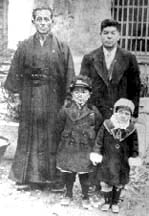Kanbun Uechi
Kanbun Uechi in Okinawa
 |
Some believe Kanbun Uechi was
born in Izumi on the Motobu Peninsula, and that he moved to the tiny
mountain village of Takinto at three or four years old. However, evidence
clearly indicates that Kanbun's parents, Kantoku and Tsuru Uechi, had
already moved to Takinto and it was in the mountain top village that Kanbun
was born on May 5, 1877.
Kanbun Uechi grew up in this area, part of a proud, traditional Okinawan
family of bushi (Samurai or Shizoku) lineage. The Uechi family farmed daikon
radishes and sold them in the village at the bottom of the mountain.
Radishes are still grown there today. |
Empty handed Okinawan fighting arts (te), kobudo,
and the samurai arts were a cultural part of rural life in Okinawa, especially
on the Motobu peninsula. More organized martial arts were being taught in the
southern areas such as Naha, Shuri and Tomari. Those systems were greatly
influenced by the martial arts of China (tote).
Areas in the southern part of the island were an insurmountable distance for a
farmer from Motobu to travel.
Kanbun learned bojutsu (staff arts) from exposure to Motobu experts such as Taru
Kise and Kamato Toyozato as well as his father, Kantoku. Kanbun often taught the
younger people of his area and led bo demonstrations that accompanied holidays
and festivals. An aged martial arts master from Tobaru named Toyama instilled in
Kanbun the desire to pursue martial arts training in China. Toyama had visited
China many times to study the martial arts and bojutsu. Though he did not leave
a lasting historic mark on Okinawa,Toyama influenced many young men in the
Motobu peninsula, including Kanbun Uechi.
Kanbun's keen interest in karate and social objections to serving in the
Japanese army provoked his decision to leave Okinawa. His parents abandoned
their earlier objections against Kanbun traveling to China in the interest of
their son's safety and life.
In March 1897, Kanbun undertook the ten-day excursion across the East China Sea
to Fuchow City in Fukein Province. He was accompanied by Tokusaburo Matsuda, a
friend from Motobu. The two young refugees, soon to be twenty years old, were
uneducated and unfamiliar with the language and ways of China.
Kanbun Uechi in China
Seiko Toyoma told this version of
Kanbun's acceptance into Shushiwa's school:
One day Shushiwa became ill with a massive headache. He did not look well so his
alarmed students sought out Kanbun Uechi and insisted that he use his medicine
to cure their teacher. Kanbun successfully healed Shushiwa with herbal mixtures.
As a result Kanbun Uechi was finally accepted as an official disciple at the Fu
Chuan Shin Temple in a secret ceremony called Pai Soo.
Like many would-be martial arts students in the last days of the 19th century,
Kanbun Uechi's first years of study were as much about patience as about martial
arts! The first three years of Kanbun's training were devoted only to the kata
Sanchin. During the first two years, training focused on strengthening the
student's body through hard work as well as martial arts practice.
In addition to karate training, Kanbun worked at farming on the temple grounds,
pulling up daikon radish roots. Another chore he performed was the cleaning and
husking of beans. The beans were placed in a large stone bowl and struck
repeatedly with the fingertips until the husks could be blown away. With this
type of work the fingertips were being trained for martial arts. In Okinawa and
China, building strength in daily work and karate training were closely related.
In the spring of 1904, the same year that war began between Japan and Russia,
Kanbun Uechi received the Menkyo Kaiden certificate naming him a master of
Chinese Pangainoon (half hard-half soft style). It was a monumental event in his
twenty-seven years of life. He had vowed to himself to become proficient in the
martial arts of China or never return to his homeland.
Kanbun became an assistant to Shushiwa, continuing his martial arts training and
lessons in Chinese literature and medicine for three more years. Kanbun felt a
strong obligation to perform and teach Pangainoon precisely as Shushiwa taught
him. He was diligent about every aspect of his teaching.
Kanbun had learned a great deal about the language and herbal medicine by that
time. The knowledge of growing, preparing and administering herbal medicine went
hand in hand with martial arts teaching. A teacher was expected to heal his
students when they were injured during training.
At thirty years of age, Kanbun opened his own dojo, the Pangainoon Kempo Sho
(Martial Arts Institute) early in 1907. He chose a town he liked called Nansei
no cho (Nansoe), approximately 250 miles southwest of Fuchow.
Kanbun Uechi was a warm hearted, affectionate man who was well like by his
students. His fierce martial arts ability was secondary to his easy, likable
demeanor. Though now teaching in his own dojo, Kanbun continued his instruction
by making semiannual visits to Shushiwa to continue his own dedicated training.
Kanbun Uechi, despite requests from his students and Shushiwa to remain, closed
his dojo in 1910 and left China forever. During his thirteen years in China,
Kanbun learned three kata. They were Sanchin, Seisan, and Sanseiryu. Kanbun
called the third kata Sandairyu. Kanbun also learned various methods of Chinese
body conditioning.
Kanbun Uechi back in Okinawa
Having satisfied his goal of
learning Chinese martial arts, Kanbun returned to his homeland of Okinawa. Not
long after arriving back, Kanbun Uechi began to receive requests to demonstrate
his formidable and notable martial arts skills. He was also frequently asked to
teach both formally and informally. The constant pressure to teach karate made
life difficult for Kanbun Uechi, who sought only seclusion.
Eventually, the pressure to teach became so intense that Kanbun had to act. At
that time, Okinawa was undergoing serious economic strife. The pressure to teach
and the severe economic climate combined to help him make a difficult decision.
Kanbun again left his homeland. He followed the lead of many Okinawan people
seeking employment during this time and at forty-seven years old decided to
travel to the industrialized area of Kansai (Osaka and Kobe), Japan.
Kanbun Uechi in Wakayama, Japan
Kanbun eventually traveled to
Wakayama and secured employment in a textile mill, the Hinomaru Sangyo Kabushki
Kaisha. The large mill, made of red tile called akarenga, produced boseki fabric
used in Japanese clothing. The factory operated twenty-four hours a day.
In April 1925, Kanbun ended his fifteen-year ban on teaching martial arts and
opened his first school in Japan. It was at this point that Uechi ryu, taught as
Pangainoon, was born. Kanbun used the living quarters (taku) in the company (kai-sha)
compound for this purpose, naming it the Shataku (company quarters) dojo. "Dojo"
is the name for a karate school. The words literally translate to "way place"
and represent the place where the way of karate is taught.
Kanbun intentionally limited the number of students he taught. New students had
to be recommended by one of the original members. That member guaranteed the
moral character and behavior of the candidate they recommended. All prospective
students were carefully screened and scrutinized by Kanbun. All students were
forbidden to display their martial arts outside the dojo. All training was
conducted secretly behind closed doors and shutters.
In March 1932, Kanbun Uechi, at
fifty-four years of age, changed the location of his dojo. He opened the
Pangainoon-ryu Karate-jutsu Kenkyu-jo in the Tebira section of Wakayama. The new
dojo, located at Showa Dori (street), less than two miles from the former
Shataku dojo, was dedicated to formalized training and personal development.
Gichin Funakoshi, who is
generally credited with being the fist Okinawan to open a dojo in Japan,
opened his Meisei Juju dojo in Koishigawa, Tokyo two years later in 1934.
The clandestine atmosphere of the Shataku dojo was left behind and the new
dojo was open to the public. Kanbun continued to screen potential students.
Only persons of an unbalanced or deceitful nature were excluded. The student
enrollment grew and Kanbun soon quit his job at the boseki factory.
|
 |
 |
Due to post war strife in
Japan, Kanbun decided to return to Okinawa. In October 1946, Kanbun Uechi,
accompanied by students Seiryo, Tsuru, and Seiyu Shinjo, Seiko Toyama and a
few others, returned to Okinawa together. Several others later returned
separately and settled in the northern portion of Okinawa.
Kanbun left the Tebira dojo in the care of Ryuyu Tomoyose. |
In January 1948, Kanbun Uechi
became ill with nephritis that he fought for eleven months. Kanbun, 71 years
old, died on Ie-jema Island on November 25, 1948. The Shinjo family were the
only ones present when Kanbun died.
Kanbun Uechi has been described by many people who knew him as a kind, gentle,
quiet man in day-to-day life but a fierce, intense, and strict instructor of
Pangainoon ryu. His life was as unique and eventful as other forefathers of
karate, as was his influence.
Back to History of
Style


